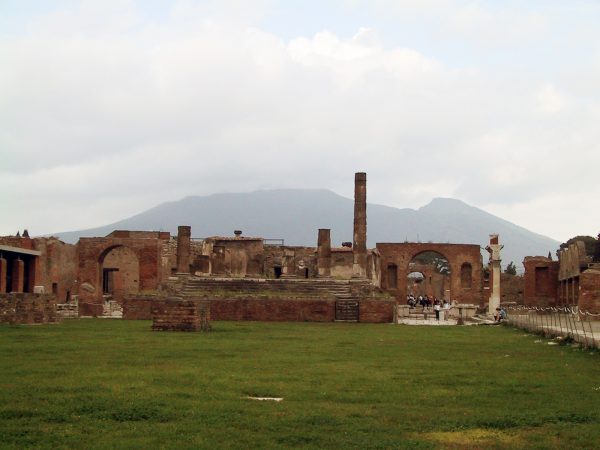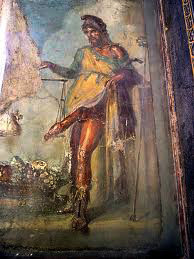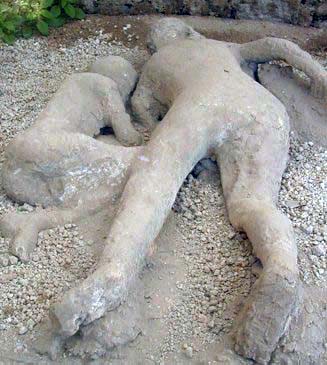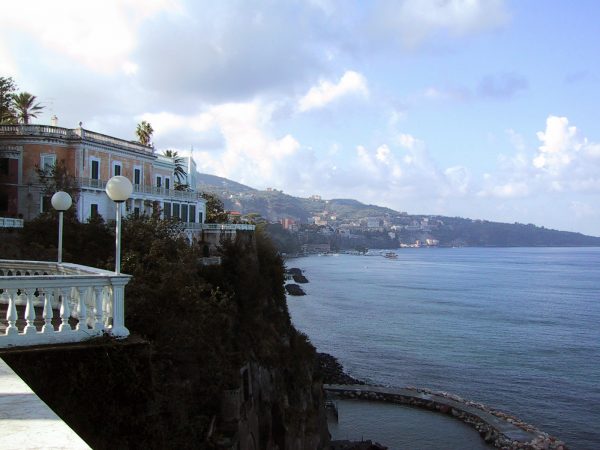We Flew from Athens to Napoli and picked up a rental car. Even though all necessary car and liability insurance is always included in Italy, we had to sign an affidavit that any theft related damamge to the car would be our responsibility. They would not cover any damage if we did not park the car in protected parking lots. NO parking on the streets in or around Napoli would be allowed.
There was a light rain and heavy traffic but we were once again in civilization (as it were). At least we’re familiar wih the ways of Italy (or so we thought). Naples is notorious for as many bad things as good. At our first toll, we met our first dishonest toll taker. The toll was 3,000 lira. I gave him a 10,000 lira note but instead of change he waved me along. “Where is my change?” I asked. He said something and yelled for me to move on. It was a that moment when I realized I needed to learn to speak Italian. I’ve been studying the language ever since.
It’s hard to understand the size of Pompeii until you go and have a visit. This was a city of possibly 20,000 inhabitants, maybe more. There are streets and shops, houses and gardens, baths and theatres and in the close distance the ever smoking peak of Mount Vesuvius.
The eruption of February 5th 62 AD did a lot of damamge to the city, so did the fire that spread through most of the city after the eruption. But Pompeii was a rich city and the Pompeiians rebuilt. Even the few tremors in the following years didn’t convince them the gods were angry.
 Although many of them probably expected it, the devastation of 79 AD still took the city by surprise. It literally buried the entire city in volcanic ash, which, as it turned out, also preserved the city. In 1738, workers rediscovered the ruins of Herculaneum when they were clearing out a space for a summer Palace for King Charles of Naples. In 1748, they continued the excavations further south and re-opened Pompeii. This is truly a great snapshot of what Roman life was like in the 1st century AD.
Although many of them probably expected it, the devastation of 79 AD still took the city by surprise. It literally buried the entire city in volcanic ash, which, as it turned out, also preserved the city. In 1738, workers rediscovered the ruins of Herculaneum when they were clearing out a space for a summer Palace for King Charles of Naples. In 1748, they continued the excavations further south and re-opened Pompeii. This is truly a great snapshot of what Roman life was like in the 1st century AD.
The frescoes in the Stabian baths and some of the villas are in remarkable condition, especially at the glorious and opulent Villa dei Misteri (Villa of the Mysteries) a short walk from the main city. The frescos on the wall depict a bride being initiated into the cult of Dionysius. The entrance floor of the another villa has a mosaic of a dog with the words “Cave Canem” (Beware of the Dog).
 At the entrance to the House of the Vetti is a frescoe of Priapus (the god of fertility) weighing his enormous penis. If you’re lucky you can see the other pornographic frescoes in one of the rooms. It was the height of fashion in Pompeii before the eruption.
At the entrance to the House of the Vetti is a frescoe of Priapus (the god of fertility) weighing his enormous penis. If you’re lucky you can see the other pornographic frescoes in one of the rooms. It was the height of fashion in Pompeii before the eruption.
The amphitheatre is the oldest in exisitence, built in 80 BC. The theatre had seating for 5,000 people. Every day life is visible from the countertops of local merchants, bakeries (with pizza ovens), a local laundry and a 10 bed brothel called a Lupinare; the women were refered to as lupas (she wolves). Carved penises on building corners and flagstones call out directions to the house.

There are remnants of storm sewers, lead pipes for plumbing, glorious courtyards and underground wine caves.
When Vesuvious erupted, people hid there, but they were buried alive as they tried to escape.Plaster casts of their bodies now lay by the entrance to the cave. There are plaster casts of many of the unfortunate ones caught in the molten path of the lava. When Pompeii was rediscovered in 1748 the hardened volcanic debris revealed the forms of those who perished. Suffocated by volcanic gasses and covered in ash and debris, their bodies eventually decayed inside the hardening matter. This decayed space formed a mold, an imprint of the body.
Archaeologists cut open the molds and filled the pockets with plaster. The resulting “plaster mummies” poignantly capture the human tragedy of Pompeii.They are gruesome yet artisitc. There is a sense of loss and horror, for the most part, there is a sense of awe and mystery, as if you were transported back in history.
Driving from Pompeii to Santa Agnes de Sorrento was an endless stop and go and stop and go and stop. At one four way intersection nothing moved for at least 15 minutes. One car was stuck in the intersection and no one would move anything except their hands to lean on their car horns.Finally, 4 or 5 large people got out of their cars and picked up the small vehicle in the intersection and moved it off the road. Everyone cheered and traffic moved on.
The rain beat on the rooftop of the converted Franciscan School, now the Hotel Romantika but at least we were out of the car. That night we ate some of the house specialty, swordfish rolls. This is also one of my specialties (and mine are much better). Italian swordfish are much oilier than the Hawaiian version we get back in San Francisco.
The next day we took a souther ride ride to Positano and around the Amalfi cliffs, winding along the switchback highway, listening to a cassette tape of Paul Simon’s “Graceland”. She made the sign of the teaspoon, he made the sign of the wave. I still can’t figure out what that means.


You must be logged in to post a comment.